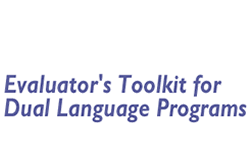Section 3: What Data to Collect:
Language Proficiency, Academic Achievement, Attitude
& Other Assessments
In this section:
Identifying what data to collect is an important step in program evaluation.
Now that you have determined what your research questions and your goals and objectives are, you need to figure out how to collect the appropriate data to answer those questions. Of course, what you might discover is that you were a little overly ambitious in your research questions because they require much more data collection than your staff is willing to do. So, this is where you get realistic about identifying what measures you can use or develop and what your timeline will be for collecting data.
You might want to form a committee that will look into some of these issues and report back to the staff at a later meeting where you can discuss your evaluation plan.
Identify Kinds of Data Needed
It is essential to identify early in the process what kinds of data will be needed to answer each of your evaluation questions. There are three types of data you might want to think about:
- Demographic data: This refers to student background data—see more about this in Section 4 – Setting up the Database. You need to think about how much background data you want. There are some standard items that you probably want: student name, student ID, grade level, ethnicity, language background, maybe SES (e.g., parent education level), language proficiency background (ELL, IFEP, EO) at entry. You may also want to consider date of birth, retention in grade, special education designation, or participation in GATE/gifted program.
- Student performance data (language proficiency and achievement test data): You need to consider how much language proficiency and achievement test data you need. Some things to consider:
- You need to meet the national, state and possibly district requirements for achievement testing—typically testing only in English. Sometimes this includes writing assessments as well.
- You should use some achievement measure in the other language of the program as well. In Spanish, you can use Aprenda3, SABE, or Supera. Beginning in 2007, California will produce a criterion-referenced test in Spanish that assesses the California State content standards for second through fourth grades (STS-Standards Test in Spanish). Other states, like Texas, may also have tests in Spanish. Assessments in languages other than Spanish are a little more difficult to obtain, as you have probably already discovered. (Check with other two-way sites to see what they are using and whether they have developed something you might be able to use or purchase or adapt for your needs. You can find out about other two-way programs from the Center for Applied Linguistics.) Be sure you use the appropriate measure if there is one required by your state.
- Most states, like California, have developed an oral language proficiency test in English to assess English oral proficiency and literacy. These tests are developed for ELL students and are not usually appropriate for native English speakers.
- NCLB requires that states administer an English language proficiency test to assess English listening, speaking, reading and writing skills. These tests are developed for ELL students and are not usually appropriate for native English speakers.
- You should collect some data measuring oral language proficiency in
the second language of the program (e.g., Spanish, Korean, Cantonese, Russian). Several possible examples are given below.
- Attitudinal data: You may want to use surveys and/or questionnaires to examine attitudes in students, parents, and/or staff at your site. These are also discussed in more detail below.
- Additional or post-program data: Dual language programs have long-term goals, and many people will be interested in the successes and experiences of those students who have finished the program, whether a K-5 or K-8 program, and are now in high school or even have finished high school. Some students who are in high school now and have completed the program at an earlier grade level may be continuing the study of Spanish content classes or Advanced Placement courses. Others may have had other experiences that were enriched by their dual language program participation, such as travel abroad. High school graduation and college enrollment rates would be of particular interest among students traditionally underrepresented in high school graduation or college enrollment. For an example of a follow-up study with types of information one could collect, you can check out the following articles by Kathryn Lindholm-Leary. These studies collected attitudinal data, grades, achievement scores, and self-ratings of achievement and language proficiency:
- Lindholm-Leary, K. J., & Borsato, G. (2005). Hispanic high schoolers and mathematics: Follow-up of students who had participated in two-way bilingual elementary programs. Bilingual Research Journal, 29, 641-652.
- Lindholm-Leary, K. J. (2003). Dual language achievement, proficiency, and
attitudes among current high school graduates of two-way programs.
NABE Journal, 26, 20-25.
While it may seem obvious that evaluation data should be used for something, many times they are only used to write reports to send to some administrator somewhere. Evaluation data can be very helpful in further designing the program to better meet the needs of students. If there are multiple measures used, as suggested above, then these data can provide a rich storehouse of information for making instructional decisions within and across grade levels to better articulate the program. Survey, interview and observational data with teachers can be used to determine how well the program is implemented, what strengths and weaknesses teachers have, and what additional training is necessary. It should now be apparent that whatever data are collected can and should be used to enhance student performance, program development and teacher training.
Decisions about Measurement Instruments
Experts recommend using multiple measures as part of an effective assessment and evaluation plan. There are four important qualities of effective assessment in two-way and developmental bilingual programs (Cloud, Genesee, & Hamayan, 2000):
- Assessments are linked to instructional activities and objectives
- Assessments are authentic
- Assessments optimize student performance
- Assessments are developmentally appropriate
National Center for Research on Evaluation, Standards and Student Testing
suggests that a strategy to design and implement assessments should meet three criteria:
- Lead to coherent, sustained learning
- Support a spiral form of teaching, each enhancing and linking what has come before
- Direct students to knowledge and skills that can be transferred or applied to new or unforeseen situations

The most common evaluation instruments are standardized tests, which measure student accomplishment in reading, language arts, and content areas (social studies, science, math). On standardized tests, the test items are developed by specialists, and norms are provided to help interpret test scores. The validity of standardized tests for ELL and other students can be enhanced with appropriate accommodations (see Abedi, 2001). These tests provide data that can be used to compare achievement across different student groups (e.g., TWI vs. non-TWI; DB vs. SEI), different sites, even different states.
More recent assessments at the state levels tend to be criterion-referenced tests (see Section 5 for information about norm- and criterion-referenced tests) that assess whether students have met the reading and content area requirements that the state has established. While it is possible to make some comparisons across student groups or school sites within a particular state, these measures cannot be used to compare the achievement of students in TWI or DB programs in one state to achievement of TWI/DB students in another state. One reason is that the measures are very different and another reason is that the expectations on which the assessments are based may differ (i.e., it may be easier in some states than in other states to meet grade-level expectations).
Besides achievement tests, a variety of measures are available that provide data on different aspects of student performance, learning, and attitudes in both languages; also parent and teacher understanding of and attitudes toward the TWI or DB program:
- Teacher-made tests
- Rubrics, rating scales that measure student ability or behavior
- Teacher observations
- Portfolios of student work
- Collective group work
- Questionnaires/surveys
You might also want to consider authentic assessment. According to Jonathan Mueller, authentic assessment refers to a "form of assessment in which students
are asked to perform real-world tasks that demonstrate meaningful application of essential knowledge and skills." It includes various forms of assessment used to understand student learning, achievement, motivation, and attitudes, including:

- Oral interviews
- Story or text retelling
- Writing samples
- Projects/exhibitions
- Experiments/demonstrations
- Teacher observations
- Portfolios
Portfolio assessment, which is a form of authentic assessment, can be defined as the "systematic, longitudinal collection of student work created in response to specific, known instructional objectives and evaluated in relation to the same criteria" (National Capital Language Resource Center).
Portfolios are advantageous in two-way and bilingual programs because they can
be used to document student progress over time in two languages. Carefully designed portfolios provide additional information to monitor student progress and to diagnose particular student concerns. They also provide teachers with good samples of work and growth to show parents at parent-teacher conferences.
Essential elements of portfolios include:
- Samples of student work (e.g., writing samples, audio or video tapes, math or science problems, reports, experiments)
- Student self-assessment (e.g., student self reflection on content or selection of work for portfolio)
- Clearly stated criteria (criteria & standards for grading student work).
In some school districts, two-way programs have employed language development portfolios that include various measures of students' oral and written language over the course of the elementary grade levels. These portfolios included annual measures of:
- Teacher ratings of students' oral proficiency in each language
- Written language samples in both languages
- Reading logs
- Parent survey on use of library & literacy sources at home
- Student surveys of literacy and attitudes
These portfolios provided an excellent source of information to document students' progress in developing language and literacy skills in the two languages. Be careful—too much documentation can be overwhelming (e.g., having teachers rate student writing samples four times a year may be too time consuming, though twice a year is manageable).
PORTFOLIO RESOURCES:
- Center for Applied Linguistics (CAL)
- Books on assessment and assessment design
- Portfolio Assessment in the Foreign Language Classroom, National Capital Language Resource Center and Center for Applied Linguistics
- Center for Advanced Research on Language Acquisition (CARLA)
- O'Malley, J.M, and Valdez Pierce, L. (1996). Authentic assessment for English language learners: Practical approaches for teachers. New York: Addison-Wesley.
Locating and Gathering Data
Having identified the kinds of data, the next step is to determine whether the data already exist and can be readily retrieved, whether they exist in paper form and need to be transferred to an electronic database, or whether new kinds of instruments need to be obtained or developed.
Many kinds of data might be readily obtained from your district assessment office, so you should check with them to see about this (see Section 4—Setting up Your Database for more information).
ORAL LANGUAGE PROFICIENCY
1. Individualized Testing
Many individualized tests are available to measure students' oral proficiency. Examples include:
- Student Oral Proficiency Assessment (SOPA) and Early Language Listening
and Oral Proficiency Assessment (ELLOPA) are language proficiency assessment instruments designed to allow young students to demonstrate their highest level of performance in oral fluency, grammar, vocabulary, and listening comprehension. - Simulated Oral Proficiency Interview (SOPI) is a performance-based, tape-mediated speaking test. SOPIs are currently available in Arabic, Chinese, French, German, Hausa, Hebrew, Indonesian, Japanese, Portuguese, Russian, and Spanish, and are intended for adolescent or adult learners of foreign languages.
- Woodcock Language Proficiency Battery—Revised (English and Spanish versions): assesses oral language skills in learners of any age.
- IDEA Proficiency Test (IPT): English & Spanish in young students
- Language Assessment Scales (LAS): English & Spanish in young students.
- Minnesota Language Proficiency Assessments (MLPA): Spanish, French, German (assesses within range of Intermediate level on ACTFL) secondary-level students
Resources for further information:
- Center for Applied Linguistics (CAL)
- Center for Advanced Research on Language Acquisition (CARLA)
- Directory of K-12 Foreign Language Assessment Instruments and Resources, Center for Applied Linguistics
2. Ratings & Rubrics
Many ratings and rubrics have been developed to assess students' oral proficiency. Most of these can be used in any language, including adaptations to uncommonly taught languages. To increase reliability, teachers or other raters should be trained in their use of these measures:
- Student Oral Language Observation Matrix (SOLOM): 5 categories (Listening comprehension, Fluency, Grammar, Vocabulary, Pronunciation). Scale ranges from 1-5 for each category.
- Stanford Foreign Language Oral Skills Matrix (FLOSEM): based on SOLOM, with same 5 categories. Scale ranges from 1-6 for each category. [Rubrics are more objective & positive than SOLOM.] The FLOSEM is available for download here.
- ACTFL Proficiency Guidelines define 4 levels of proficiency (Novice, Intermediate, Advanced, Superior). These were developed for assessing secondary-level foreign language students.
Oral Proficiency Resources:
- Center for Applied Linguistics (CAL)
- Center for Advanced Research on Language Acquisition (CARLA)
- Fairfax County Public Schools – PALS: Performance Assessment for Language Students (lots of rubrics for different tasks)
- O'Malley, J.M, and Valdez Pierce, L. (1996). Authentic assessment for English language learners: Practical approaches for teachers. New York: Addison-Wesley.
ATTITUDINAL DATA
Collecting attitudinal data can be very helpful in providing information about the program.
- Students — ratings of academic competence, satisfaction with program and school/classroom climate, motivation, cross-cultural attitudes, language use outside of school.
- Teachers/Administrators/Staff — satisfaction with program (assessment of problems), attitudes toward program and other staff, level of and additional needs for training.
- Parents — satisfaction with program (assessment of problems), frequency of literacy activities in home, training needs, use of target language in home, participation in cultural activities.
- Some sample questionnaires for students, teachers/staff, and parents are available for download here.
Collecting Data on Program Implementation
In Section 1, we recommended preparing an Evaluation Notebook that would,
among other things, describe the program design and selected instructional strategies. In Section 2, we looked at some examples of implementation questions and goals that a program might want to investigate. The evaluation process can
help ensure that the program actually operates in the way it was described and in the way program staff agreed upon. Implementation data can be collected in a variety of formats—classroom observation protocols to document the use of immersion or bilingual strategies, notes from teacher interviews and focus groups, surveys of teachers regarding their practices and their perceptions of how effective the implementation is.

Implementation data can play an important part in interpreting your outcomes. If outcomes were not as good as expected, and the program was not consistently implemented, you have clear implications for change and possibly professional development as well. If the program was consistently implemented as planned, and the outcomes were still not as good as expected, you might need to rethink the design of your program. Implementation information is a key element in a comprehensive program evaluation.
A good tool for examining the quality of your implementation is the Guiding Principles for Dual Language Education, as mentioned in Section 1.
Why Develop a Timeline?

A timeline is helpful so that you can visualize what data need to be collected at what time periods. You don't want to be collecting data at peak times that other things are going on or when students are a little overwhelmed with the beginning or ending of school. Some time periods you may want to avoid:
- The last couple weeks of school, holidays, just before or after a vacation
- Peak work times for staff: report cards, parent/teacher conferences
- Field trips
After filling in your timeline, you may see that you need to make some adjustments
in what data you can collect or when you should collect it.
SUGGESTIONS & EXAMPLES: Developing Your Own Data
Collection Plan & Timeline
![]() This is a much easier task than you might think, especially if you see an example, so check out the example below, and then develop your own. Put this information in your Evaluation Notebook.
This is a much easier task than you might think, especially if you see an example, so check out the example below, and then develop your own. Put this information in your Evaluation Notebook.
- View/download a template for your program's data collection plan and timeline in PDF or Word
- View/download an example of a program's data collection plan and timeline
in PDF or Word

